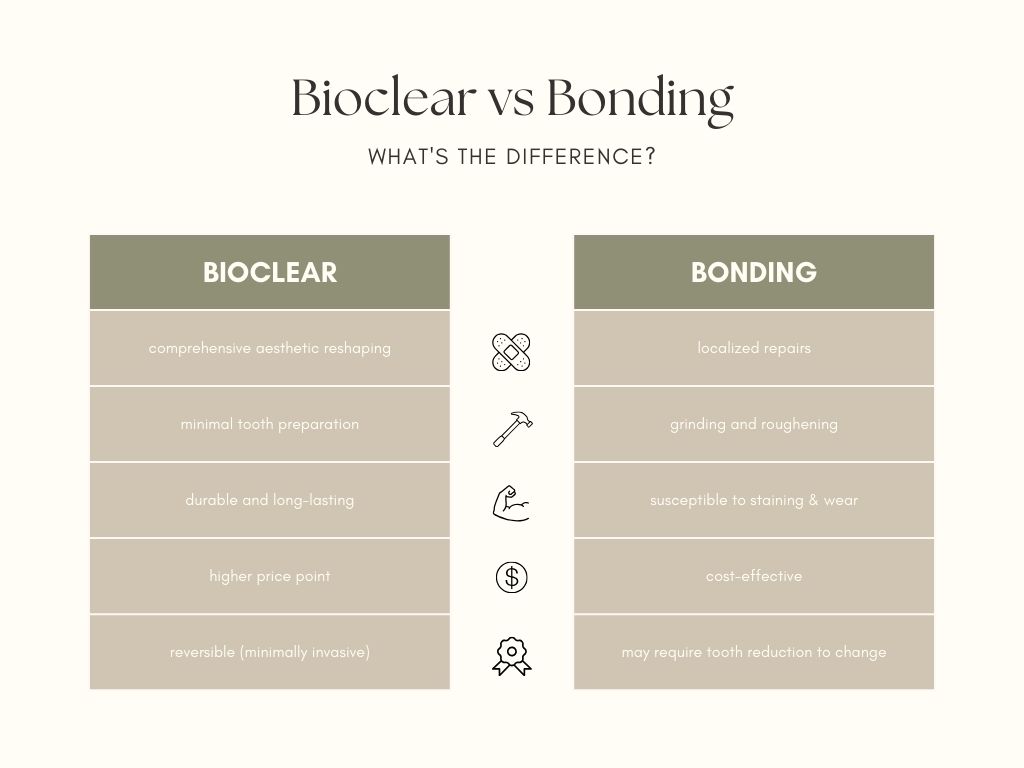Introduction
When it comes to restoring and enhancing the appearance of your teeth, modern dentistry offers a range of effective treatment options. Two popular choices are Bioclear and Bonding, both of which aim to improve the aesthetics and functionality of your smile. However, understanding the key differences between these two approaches is crucial to making an informed decision about which one is right for you.
What is Bioclear?
Bioclear, also known as tooth sculpting or composite veneers, is a minimally invasive cosmetic dental treatment that involves the application of a tooth-colored resin material to the surface of your existing teeth. This procedure is designed to reshape, recolor, and enhance the overall appearance of your smile by addressing issues such as chips, cracks, discoloration, or minor misalignments.
The Bioclear process typically involves the following steps:
1. Preparation: Your dentist will lightly etch the surface of your teeth to create a rough texture, which helps the resin material adhere better.
2. Application: The tooth-colored resin is carefully applied and sculpted onto your teeth, allowing your dentist to reshape, lengthen, or alter the color and shape as desired. Bioclear uses innovative anatomically shaped mylar forms in which the composite is injection molded. This ensures a natural-looking and strong buildup of composite.
3. Curing: A specialized light is used to cure and harden the resin material, ensuring a durable and long-lasting result.
4. Polishing: Finally, your dentist will sculpt and polish the treated teeth, giving them a smooth, natural-looking shape and finish.
While Bioclear offers some advantages, it’s important to understand how it stacks up against other common filling materials:
What is Bonding?
Dental bonding, also known as tooth bonding, is a similar cosmetic procedure that involves the application of a tooth-colored resin material to the surface of your teeth. However, unlike Bioclear, bonding is typically used to address more localized issues, such as filling areas where decay is removed, repairing chips, cracks, or gaps between teeth.
The bonding process is as follows:
1. Preparation: Your dentist will roughen the surface of the tooth to be treated and apply a conditioning liquid to help the bonding material adhere.
2. Application: The tooth-colored resin is applied directly to the affected area and shaped to match the contours of your existing tooth.
3. Curing: A specialized light is used to cure and harden the resin material.
4. Polishing: The bonded area is polished to blend seamlessly with the rest of your tooth.

Comparing Bioclear and Bonding
While both Bioclear and bonding share some similarities, such as using tooth-colored resin materials and enhancing the appearance of your smile, there are several key differences to consider:
1. Scope of Treatment: Bioclear is typically used to address more comprehensive aesthetic concerns, such as reshaping and recoloring multiple teeth. Bonding, on the other hand, is better suited for addressing localized issues, like repairing chips or closing small gaps.
2. Preparation: Bioclear often requires minimal to no tooth preparation, as the resin is applied directly to the existing tooth surface. Bonding may involve slightly more preparation, such as roughening the tooth surface to improve adhesion.
3. Durability: Bioclear composite veneers are generally more durable and long-lasting than bonding, with proper care and maintenance. Bonding material can be susceptible to staining, chipping, or wear over time, especially in areas of high bite pressure.
4. Cost: Bioclear treatments tend to be more expensive than bonding, as they typically involve treating multiple teeth and require more time and materials.
5. Reversibility: Bioclear is considered a reversible procedure, as the composite resin can be removed or replaced without significant damage to the underlying tooth structure. Bonding, while less invasive than veneers or crowns, may require some tooth reduction if the bonding needs to be replaced or removed.
6. Maintenance: Both Bioclear and bonding require regular dental checkups and proper oral hygiene practices to maintain their appearance and prolong their lifespan. However, Bioclear composite veneers may be more resistant to staining and wear compared to bonding material due to the monolithic nature of the molded composite and the extensive polishing of the surface.

Factors to Consider
When deciding between Bioclear and bonding, it’s essential to consider your specific needs, preferences, and budget. Here are some factors to keep in mind:
1. Extent of Dental Issues: If you have more extensive cosmetic concerns, such as severe discoloration, black triangles, misshapen teeth, or multiple teeth requiring treatment, Bioclear may be the better option as it can address these issues more comprehensively.
2. Budget: Bonding is generally more affordable than Bioclear, making it a cost-effective solution for minor cosmetic issues or those on a tight budget.
3. Durability Needs: If you’re looking for a longer-lasting solution, Bioclear composite veneers may be the better choice, as they tend to be more durable and resistant to staining and wear compared to bonding material.
4. Maintenance Commitment: Both treatments require proper oral hygiene and regular dental visits for maintenance. Consider your willingness and ability to commit to the necessary maintenance routines.
5. Aesthetic Preferences: Bioclear may offer more flexibility in terms of reshaping and recoloring your teeth, while bonding is better suited for addressing specific, localized cosmetic issues.
Maintenance and Aftercare Tips
Maintaining the results of your Bioclear or bonding treatment is essential to ensure its longevity and preserve the beautiful appearance of your smile. Here are some practical tips and advice to help you care for your new smile:
Oral Hygiene Practices:
- Brush twice a day with a soft-bristled toothbrush and toothpaste. Proper brushing techniques will help remove plaque and prevent staining.
- Floss daily to remove food particles and debris from between your teeth and around the treated areas.
- Consider coconut oil pulling and tongue scraping.
Dietary Considerations:
- Avoid hard, crunchy, or sticky foods that can chip or dislodge the resin material used in Bioclear or bonding.
- Limit your consumption of staining beverages like coffee, tea, red wine, and dark-colored sodas, as they can discolor the resin over time.
- If you smoke or use tobacco products, consider quitting, as these habits can stain and discolor your treated teeth.
Touch-up Treatments:
While Bioclear and bonding are designed to be long-lasting, they may eventually need touch-ups or replacements due to wear and tear.
- Schedule regular dental check-ups (every 6 months or as recommended by your dentist) to monitor the condition of your Bioclear or bonding treatment.
- If you notice any chips, cracks, or discoloration, contact your dentist promptly to discuss touch-up options.
- Be prepared for potential reapplication or replacement of the resin material after several years, depending on the extent of wear and your individual habits.
By following these maintenance and aftercare tips, you can help extend the lifespan of your Bioclear or bonding treatment and keep your smile looking its best for years to come. See the before and after images of bioclear!
Consulting with a Dental Professional
Ultimately, the decision between Bioclear and bonding should be made in consultation with a qualified dental professional who has been accredited through the Bioclear hands-on training in Tacoma, Washington. Your Bioclear dentist can evaluate your specific dental needs, discuss your goals and expectations, and provide personalized recommendations based on your unique situation.
During your consultation, be sure to ask questions about the process, potential risks or side effects, expected results, and any post-treatment care or maintenance required. Your dentist can also provide estimates for the cost of each treatment option and discuss any potential insurance coverage or payment plans.
By understanding the key differences between Bioclear and bonding, and working closely with your dentist, you can make an informed decision that aligns with your cosmetic goals, budget, and overall oral health needs.
By scheduling a personalized consultation, you’ll be one step closer to achieving the beautiful, confident smile you’ve been dreaming of.
Frequently Asked Questions
When considering Bioclear or bonding treatments, it’s natural to have questions and concerns. To help address some of the most common inquiries, we’ve compiled the following Frequently Asked Questions (FAQ)
If you have any additional questions or concerns, don’t hesitate to reach out to Dr Sharon Dickerson, a qualified cosmetic dentist for personalized guidance and advice.

